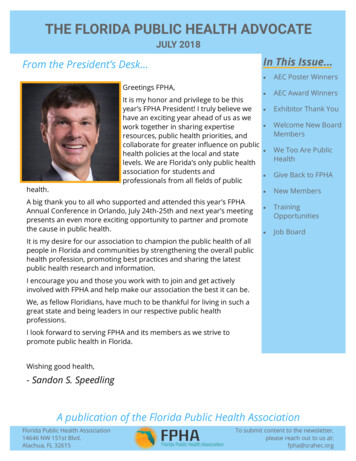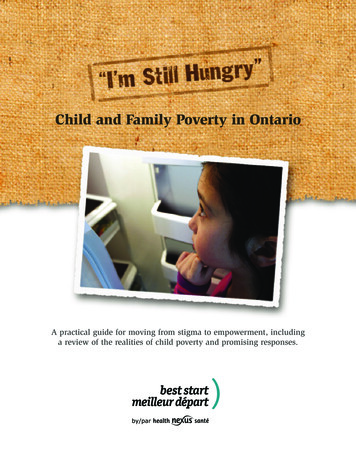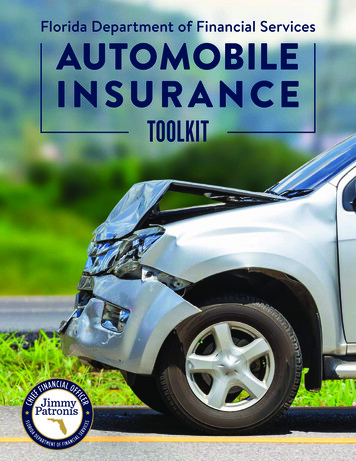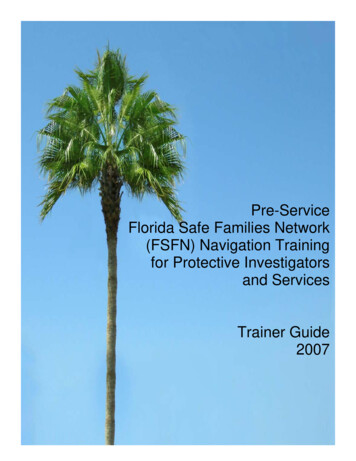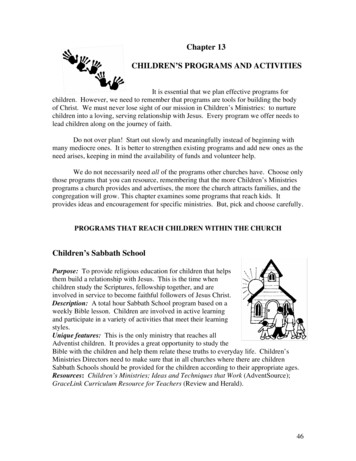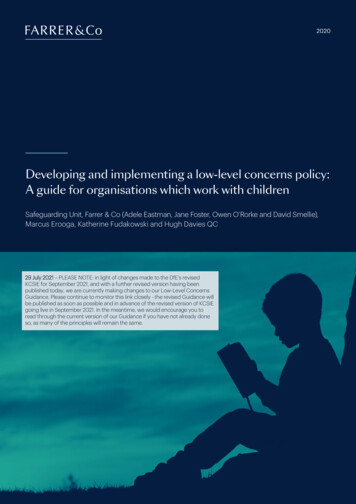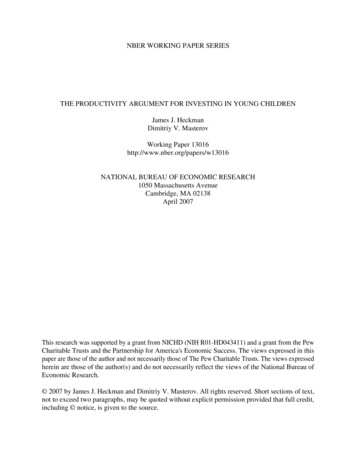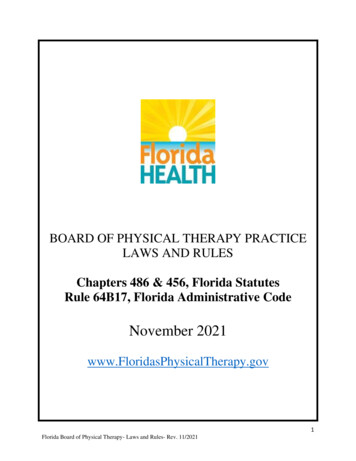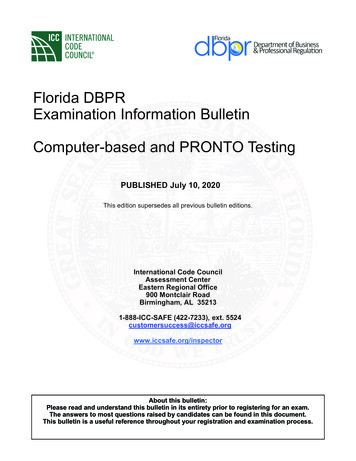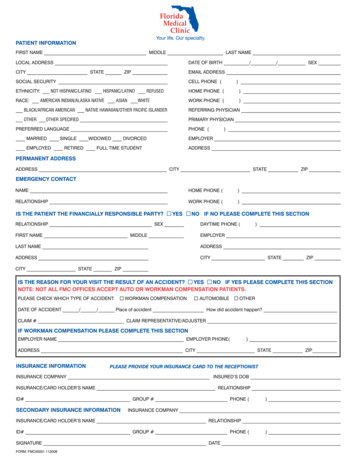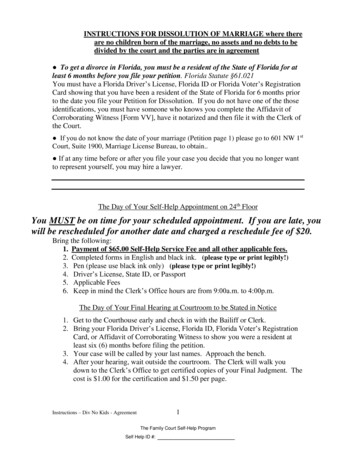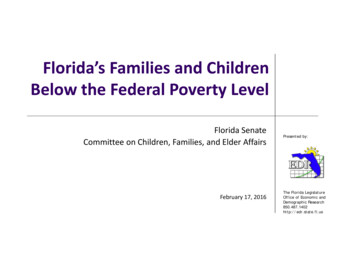
Transcription
Florida’s Families and ChildrenBelow the Federal Poverty LevelFlorida SenateCommittee on Children, Families, and Elder AffairsFebruary 17, 2016Presented by:The Florida LegislatureOffice of Economic andDemographic Research850.487.1402http://edr.state.fl.us
The Official Federal Poverty Threshold What does the official federal poverty threshold measure?– Whether the cash income of related persons in a household is below a certain monetarythreshold. What is the poverty monetary threshold based on?– The poverty threshold is the cost of a minimum annual food diet in 1963 (times 3 toallow for other expenses) in today’s prices. Who estimates poverty rates?– Today, the US Census Bureau calculates poverty thresholds for different family sizes andindividuals from income data based on surveys. The methodology was originally developed in 1963 by the Social Security Administration staff. What are the major groups that are included/excluded in povertycalculations?– Included: All persons living in households, even if it is a household consisting of one person.– Excluded: Foster children under age 15. Institutionalized population (such as prisons and mental hospitals).Page 1
The Official Federal Poverty Statistics How are poverty statistics used?– The official federal poverty measures are primarily used to determineeligibility for federal and state programs. They are also used as a measureof a state’s well‐being relative to other states. What are the limitations?– There are different views on how the official poverty threshold should bemeasured.– Survey data are typically self‐reported, and thus may underestimateincome. In fact, some researchers are concerned the official survey measuring povertyrates may be overestimating the percent of people in poverty. What is meant by the term “in poverty”?– Throughout this presentation, the term “in poverty” refers to thosehouseholds or individuals below the poverty threshold.Page 2
How Cash Income Is Measured �–EarningsUnemployment compensationWorkers' compensationSocial SecuritySupplemental Security IncomePublic assistanceVeterans' paymentsSurvivor or disability benefitsPension or retirement incomeInterest, dividendsIncome from rentsIncome from estates, trustsEducational assistanceAlimony, child supportAssistance from outside the household Measured before taxes Excludes:– Noncash benefits Supplemental Nutrition AssistanceProgram (SNAP) Special Supplemental Food Programfor Women, Infants andChildren (WIC) National school lunch Housing subsidies Low‐income home energy assistance Medical care (such as Medicare andMedicaid)– Capital gains or losses– Assets (liquid or illiquid) Home ownership Bank accounts Retirement accountsGovernment programs may have additional and/or different criteria to determinepoverty status for eligibility and may define income and poverty differentlydepending on the purpose.Page 3
Florida’s Population in Poverty Population for whom poverty is determined (18,946,215)Adults (14,989,964) 14.7% of adults are in poverty (2,205,911) Poverty rates for adults:Age GroupPercent of Age Group 5413.3%55‐6412.9%65‐749.7%75 10.9%Children (3,956,251) 24.1% of children are inpoverty (953,348)Source: US Census Bureau, American Community Survey, 5-Year, 2010-2014, Table B17024. Poverty rates for children:Age GroupPercent of AgeGroup in Poverty0‐526.8%6‐1124.3%12‐1721.3%Page 4
Florida Households and Families in Poverty Households(7,217,508)Families(4,650,162)Families inPoverty (566,521)Families in Povertywith Related Childrenunder the Age of 18(399,922) Households (7,217,508):– 4,650,162 family.– 2,567,346 non‐family (ahouseholder living alone orwith non‐relatives only). Households in poverty(1,094,402):– 566,521 family householdsin poverty (12.2% offamilies or 2,300,543people)– 527,881 non‐familyhouseholds in poverty(20.6% of non‐familyhouseholds or 858,716people).Source: US Census Bureau, American Community Survey, 5-Year, 2010-2014, Tables B17010, B17017, and B17021.Page 5
Children in Poverty. In Florida, 24.1% of allchildren under 18 yearsfor whom poverty isdetermined are in poverty(953,348 children).– Of the children in poverty,44.3 percent are in deeppoverty (below 50% ofpoverty threshold).– This means that 10.7percent of all children inthe state are in deeppoverty.Page 6
Children in Poverty. Of the 556,521 families in poverty in Florida:– 70.6% (399,922 families) have related children under the age of 18. These 399,922 families have 937,243 related children under the age of 18. There are an additional 16,105 children in poverty who are unrelated to thehouseholder, including foster children aged 15‐17. There are a total of 953,348 children in poverty in Florida.Families and Children in Poverty in Florida556,521 families399,922 familieswith relatedchildren under 18937,243 children953,348 children16,105 childrenSource: US Census Bureau, American Community Survey, 5-Year, 2010-2014, Tables B17006, B17010, & B17024.Page 7
Recent Children’s Poverty Rate Is Higher thanPre‐Recession Levels but Is Starting to Improve In 2006, 17.6% of all children under 18 were in poverty. The poverty rate for childrenpeaked at 25.6% in 2012. More recently in 2014, the rate was slightly above 24%. In the economic boom years of 2004 to 2007, Florida had slightly lower poverty ratesfor children than the nation, but since then Florida’s poverty rate has been higher thanthe nation. For all persons of all ages, the percent in poverty increased from 12.6 in 2006 to 16.6 in2014.Page 8
Characteristics of Floridians in Poverty. Families Race/Ethnicity– Family Structure Population Diversity– Family Size– 65 and Older– Children– Disability Status by EmploymentStatus Educational Attainment Geographic Representation AgePoverty Thresholds by Size of Family and Number of Children - 2014Related children under 18 yearsSize of family e person (unrelated individual).Under 65 years.65 years and over.12,07112,31611,35412,31611,354Two people.Householder under 65 years.Householder 65 years and ee people.Four people.Five people.Six people. Nine people or more.Source: U.S. Census 551,98451,39650,430 Eight ormore45,768Page 9
Families in Poverty are Usually Single‐Parent. Nearly 70% of families in poverty with children are headedby a single‐parent.– Of the 566,521 Florida families with or without children in poverty, almosthalf are families where there is a female householder, with no husbandpresent.Source: US Census Bureau, American Community Survey, 5-Year, 2010-2014, Table B17010.Page 10
Children in Poverty by Family Structure. Two‐thirds of all children in poverty live with a single parent.– More children in poverty live in families with a female householder, nohusband present than in married‐couple families and in malehouseholder, no wife present families combined. Over two‐thirds of children at or above poverty live in marriedcouple families.Source: US Census Bureau, American Community Survey, 5-Year, 2010-2014, Table B17006.Page 11
Families in Poverty Compared to US. Compared to the US, Florida currently has a slightly larger percent offamilies in poverty (12.2% in Florida vs. 11.5% in the US). Married couples represent a higher percentage of families in poverty inFlorida, than in the US (39.6% vs. 36.3%). Female householder, no husband present represent a smallerpercentage of those families in poverty in Florida than in the US (49.3%vs. 53.0%), while the share of male householder, no wife present islarger.Page 12
Family Size is Larger. Florida’s families inpoverty are typicallylarger in size than thoseat or above poverty. Only 38.7% of families inpoverty contain 2people, while themajority of families at orabove the povertythreshold are comprisedof 2 people (52.8%). 18.2% of families inpoverty have 5 or morepeople, while 9.5% offamilies at or above thepoverty threshold contain5 or more people.Page 13
Families in Poverty with Related Children. 20.3% of Florida’s families in povertyhave 3 or more related children,compared to 5.8% of those familiesthat are at or above poverty.– Of the families below poverty with 3or more related children, 56.4%(64,953 families) are femalehouseholders, no husband present.Page 14
Educational Attainment is Lower. The higher theeducational attainmentlevel, the smaller thepercent in poverty. 60.5% of Florida’s familiesbelow poverty have ahouseholder with a highschool degree or less,while 33.6% of families ator above poverty have ahouseholder with a highschool degree or less. Families with ahouseholder with lessthan a high school degreecomprise a substantiallylarger share of families inpoverty than of those thatare at or above thepoverty level.Page 15
Age of Householder is Younger. For Florida’s family and non‐family households:– Of households in poverty, 9.1%have a householder under 25years old, while 2.2% ofhouseholds above poverty are inthis age group.– Of households in poverty, 34.1%have a householder 25‐44 yearsold, while 28.3% of householdsabove poverty are in this agegroup. In contrast, a larger share ofolder householders make up thefamilies and non‐families thatare at or above the povertylevel.Page 16
Racial and Ethnic Composition of Families inPoverty is Non‐White. The percent of families inpoverty based on the raceof the householder varies.These percentages runfrom 9.8% for White to23.7% for Black or AfricanAmerican. 18.7% of families wherethe householder is ofHispanic or Latino origin(of any race) are inpoverty.Source: US Census Bureau, American Community Survey, 5-Year, 2010-2014, Table S1702.Page 17
Population 65 Years and Over in Florida. Of the 3,453,205 Floridians 65 years and over for whom povertystatus is determined, 10.2% or 353,406 people are in poverty.– This represents 11.2% of all Floridians in poverty. Of the people 65 years and over in poverty, 29.8% are in deeppoverty (income below 50% of the poverty level). There are 240,254 households in poverty, where the householderis 65 years and over:– 70,989 are family households.– 169,265 are non‐family (people living alone or with nonrelatives).Page 18
Disability Status by Employment Status forFloridians in Poverty For Florida’s populationaged 20 to 64 in poverty18.0% (315,238) have adisability. The majority of theseindividuals with adisability are not in thelabor force (75.2%).Persons 20-64 in PovertyDisabled Persons in Poverty Of the 24.8% that are inthe labor force, they arealmost equally splitbetween those that areemployed andunemployed. These statistics differfrom the disabled whoare not in poverty, wherea greater percentage areemployed (37.4%).Page 19
Florida’s Poverty Rates by County Poverty rates vary by county. 40 of Florida’s counties havea poverty rate at or abovethe state’s rate of 16.6%.– Most of these areas are inthe Heartland and Northernpart of the state.– Many of these countieswould be considered rural.– However, half of Florida’smost populous 10 countiesalso have rates above thestate average:Florida16.6%Highest Poverty Rate of 31.7% in Hamilton CountyLowest Poverty Rate of 8.2% in St. Johns County Hillsborough (16.8%), Polk(18.1%), Duval (18.2%),Orange (18.2%), and Miami‐Dade (20.4%).Source: US Census Bureau, Small Area Income and Poverty Estimates, 2014.Page 20
Change in Poverty Rates between 2006 and 2014 The poverty rate in 35 ofFlorida’s counties increasedby 4.0 percentage points ormore between 2006 and2014.– In five counties, the povertyrate declined over this timehorizon.Florida4.0% Sumter (‐2.2%), DeSoto(‐0.6%), Escambia(‐0.6%), Alachua (‐0.2%), andJackson (‐0.1%).– The greatest increase in thepoverty rate was inOkeechobee County (9.9percentage points).Source: US Census Bureau, Small Area Income and Poverty Estimates, 2006 and 2014.Page 21
SUPPLEMENTAL INFORMATION:Examples of Poverty and Low‐Income Programs These examples of major poverty and low‐income programs are primarily federallyfunded, federally funded with a required level of state effort, or funded by sharedfederal/state funds. They typically try to address specific needs. Healthcare Assistance– KidCare/CHIP (200K enrolled, 418M)– Medicaid (4M enrolled, 24.6B) Housing Assistance– Florida Low‐Income Home Energy AssistanceProgram (LIHEAP) ( 69M)– Florida Weatherization Assistance Program ( 2M)– Low‐Income Emergency Home Repair Program– Emergency Financial Assistance for Housing Program (EFAHP)– HUD Programs e.g. public housing, housing choice vouchers, Section 8 (195,737housing units, 421,696 occupants)Page 22
Examples of Poverty and Low‐Income Programs(continued) Food Assistance– Emergency Food Assistance Program (TEFAP) ( 23M)– Florida Special Supplemental Nutrition Program for Women, Infants, and Children (WIC)(467K recipients, 103M)– National School Lunch Program (NSLP) (1.7M participants) School Breakfast Program (SBP) (787K participants)Summer Food Service Program (SFSP) (163K participants)Afterschool Snack ProgramSeamless Summer Option ProgramSpecial Milk Program (SMP) (110K half pints served)– Child Care Food Program (CCFP) Afterschool Meals Program Homeless Children Nutrition Program– SNAP/Florida Food Assistance Program (3.7M recipients, 5.7B) Tax Breaks and Cash Assistance to Alleviate the Conditions of Poverty– Federal Earned Income Tax Credit (2.2M recipients, 5.1B)– Community Services Block Grant Program ( 22M)– TANF (49K recipients, 160M)Page 23
Examples of Poverty and Low‐Income Programs(continued) At‐Risk and Prevention Programs–––––––––––Florida Head Start Program (46K participants)School Readiness Program (226K participants)Take Stock in Children ( 6.1M)College Reach Out Program ( 1.0M)Adult Education – GED ( 22.2M state dollars)First Generation in College Matching Grants (8.7K recipients, 10.6M)Florida Student Assistance Grants (131.8K recipients, 146.8M)Florida Work Experience Program (629 recipients, 1.6M)Florida Prepaid Scholarships ‐ Project STARS ( 7.0M)Pell Grants (596K recipients at Florida institutions, 2.1B)CareerSource Florida e.g. SNAP Employment and Training, TANF Welfare Transition Poverty Avoidance– Florida Reemployment Assistance– Social SecurityPage 24
20.3% of Florida’s families in poverty have 3 or more related children, compared to 5.8% of those families that are at or above poverty. – Of the families below poverty with 3 or more related children, 56.4% (64,953 famil
